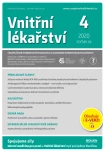Long term use of the telemonitoring system Diani in the therapy of a patient with type 1 diabetes
Authors:
Jan Brož 1; Anna Holubová 2,3; Jan Mužík 2,3; Martina Vlasáková 3,4; Miroslav Mužný 2,3,4; Alice Králová 5; Lucie Hoskovcová 1; Denisa Janíčková Ž Árská 1; Eirik Arsand 6,7; Michaela Hronová 1,4; Jana Urbanová 8; Milan Kvapil 1
Authors‘ workplace:
Interní klinika 2. LF UK a FN Motol Praha
1; Fakulta biomedicínského inženýrství ČVUT Praha
2; Centrum podpory aplikačních výstupů a spin‑off firem 1. LF UK Praha
3; 1. LF UK Praha
4; Interní klinika FN Ostrava
5; Norwegian Centre for E‑Health Research, University Hospital of North Norway, Tromsø, Norway
6; Department of Clinical Medicine, UiT – The Arctic University of Norway, Tromsø, Norway
7; II. interní klinika 3. LF UK a FNKV Praha
8
Published in:
Vnitř Lék 2020; 66(4): 87-91
Category:
Case Report
Overview
Mobile and wearable technologies offer patients with diabetes mellitus new possibilities for data collection and their more effective analysis. The Diabesdagboga smartphone application and the Diani web portal enable to collect and analyze glycaemia values, carbohydrates intake, insulin doses and the level of physical activity. The data are not only accessible in the corresponding smartphone but also automatically transferred to an Internet portal, where they may be completed by the records from an electronic pedometer and continuous glucose monitor. All these data may then be displayed in various types of graphical outputs and are available to both the patient and the physician. The case report of a patient who has used the system for almost two years shows a significant improvement in metabolic compensation (a decrease in the mean HbA1c value by 18.6 mmol/mol as compared with the previous period).
Keywords:
Telemedicine – HbA1c – diabetes diary – diabetes mellitus – hypoglycaemia – mobile application – telemonitoring – web application – web portal
Sources
1. AbuDagga A, Resnick HE, Alwan M. Impact of blood pressure telemonitoring on hypertension outcomes: a literature review. Telemed J E Health 2010; 16: 830–838.
2. Inglis SC, Clark RA, McAlister FA, et al. Structured telephone support or telemonitoring pro‑ grammes for patients with chronic heart failure. Cochrane Database Syst Rev 2010; CD007228.
3. McLean S, Chandler D, Nurmatov U, et al. Telehealthcare for asthma. Cochrane Database Syst Rev 2010; 10: CD007717.
4. Brzan PP, Rotman E, Pajnkihar M, et al. Mobile Applications for Control and Self Management of Diabetes: A Systematic Review. J Med Syst 2016; 40: 210.
5. Ramachandran A, Snehalatha C, Ram J, et al. Effectiveness of mobile phone messaging in prevention of type 2 diabetes by lifestyle modification in men in India: a prospective, parallel‑group, randomised controlled trial. Lancet Diabetes Endocrinol 2013; 1: 191–198.
6. Muzny M, Muzik J, Årsand E, et al. Experience with Design of a Smartwatch Diabetes Diary Application. International Journal on Biomedicine and Healthcare 2015; 3: 22–24.
7. Muzik J, Broz J, Holubová A, et al. Telemedicine tools for automated generation of dia‑ betes diary. Diabetes Technology & Therapeutics. February 2016, 18: A-1-A-140.
8. Holubová, A, Janíčková Žďárská D, Oulická M, et al. Kroková zátěž u pacientů s diabetes mellitus 1. typu a hodnocení vlivu míry a intenzity chůze na hodnotu glykemie. DMEV 2015; 18: (Suppl. 1): 52–53.
9. Muzik J, Broz J, Oulicka M, et al. Integration platform for diabetes related biosignals. Diabetes Technology & Therapeutics. February 2015, 17: (S1): A-1-A-180.
10. Årsand E, Muzny M, Bradway M, et al. Performance of the first Combined Smartwatch/ Smartphone Diabetes Diary Application Study. J Diabetes Sci Technol 2015; 9: 556–563.
11. Gold AE, MacLeod KM, Frier BM. Frequency of severe hypoglycemia in patients with type I diabetes with impaired awareness of hypoglycemia. Diabetes Care 1994; 17: 697–703.
12. Czupryniak L, Barkai L, Bolgarska S, et al. Self‑monitoring of blood glucose in diabetes: from evidence to clinical reality in Central and Eastern Europe--recommendations from the international Central‑Eastern European expert group. Diabetes Technol Ther 2014; 16: 460–475.
Labels
Diabetology Endocrinology Internal medicineArticle was published in
Internal Medicine

2020 Issue 4
Most read in this issue
- Liver fibrosis
- Evaluation of surgical risk in patients with liver cirrhosis
- Microscopic polyangiitis
- Hyperuricemia in renal disease patients
